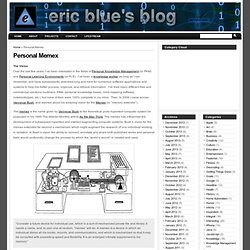

Bing vs Google, the quiet semantic war « Shepherd’s Pi. On Wednesday night I had dinner at a burger joint with four old friends; two work in the intelligence community today on top-secret programs, and two others are technologists in the private sector who have done IC work for years. The five of us share a particular interest besides good burgers: semantic technology. Oh, we talked about mobile phones (iPhones were whipped out as was my Windows Phone, and apps debated) and cloud storage (they were stunned that Microsoft gives 25 gigabytes of free cloud storage with free Skydrive accounts , compared to the puny 2 gig they’d been using on DropBox ). But we kept returning to semantic web discussions, semantic approaches, semantic software.
One of these guys goes back to the DAML days of DARPA fame, the guys on the government side are using semantic software operationally, and we all are firm believers in Our Glorious Semantic Future . Here’s a quick and friendly video by Metaweb explaining their approach to representing semantic meaning: Personal Memex. The Vision Over the last few years, I’ve been interested in the fields of Personal Knowledge Management (or PKM) and Personal Learning Environments (or PLE).

I’ve been a knowledge worker as long as I can remember, and have subsequently searched long and hard for numerous software applications and systems to help me better process, organize, and retrieve information. I’ve tried many different free and commercial solutions (outliners, PIMs, personal knowledge bases, mind mapping software, notebooks/pad, etc.), but none of then were 100% complete in my mind.
Then, In 2006 I came across Vannevar Bush, and learned about his amazing vision for the Memex (or “memory extender”). The memex is the name given by Vannevar Bush to the theoretical proto-hypertext computer system he proposed in his 1945 The Atlantic Monthly article As We May Think. “Consider a future device for individual use, which is a sort of mechanized private file and library. What is It, and What Can It Do?
Core Components in Use. Coming soon: the disruptive molecular age of information. Now we’ve seen what Google has had up its sleeve with Google Buzz.

I expect this is the last tool of the atomic age. No, not the energy field, the real-time content field. “Huh?” Before I start, tomorrow I’m giving a talk to Stanford University MBA students with MC Hammer and Loic Le Meur, founder/CEO of Seesmic (he wrote about his part of the presentation on his blog tonight) about what social media is doing to our marketing, and I’ve been working with a few companies on products that will come out over the next year that will move us from an atomic age of information streams to a molecular one, so wanted to talk about it, both here, and tomorrow at Stanford to see what bubbles up.
Look at Google Buzz. Or look at Twitter. Same with YouTube videos. How about photos? Go to Facebook or Google Buzz. Joining information atoms takes a LOT of work and a LOT of energy. Let’s discover what this molecular age of information might look like and what it might enable. I bet you can’t. Want them? 1.